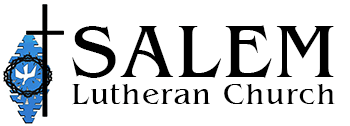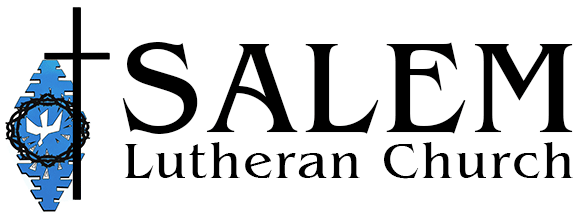The History of Salem Lutheran
Let this be written for future generations, so that a people yet unborn may praise the Lord. — Psalm 102:18
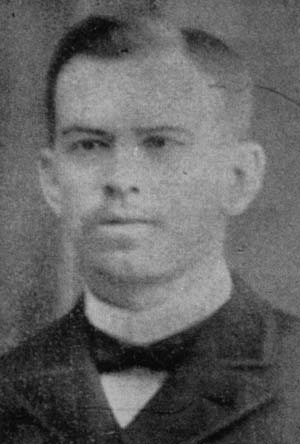
(1892-1895)
1892
On October 20th Reverend Dreher from Emmanuel started the new congregation called “Salem”. The word Salem is derived from the Hebrew word meaning “Peace.” Services were held in the Lange store for a short time. Soon a lot on the corner of South Robert Street and Bunker was purchased. Along with Reverend Dreher, charter members were: H.F. Lange, John Kulenkamp, J. Helmbusch, Jacob Bohrer, C. Gruening and Aug Mews.
1894
Salem church was built on the lot. Gustave Semmler was the contractor.
1895
Reverend Dreher left Salem, and in July the congregation asked Reverend William Utesch of St. Paulus in South St. Paul to come preach to them. Reverend Utesch moved his residence to a rented parsonage on South Robert Street. He soon became the second pastor of Salem.
1900
Through an exchange of pastors, Reverend Uteach went to Texas, and Reverend David Lebahn came to Salem from Texas. On July 1 Reverend Lebahn was installed.
1901-1908
The church was renovated by an active Choir and Young People’s Society. The Ladies’ Aid bought the pews. Mr. Gustave Semmler built an altar and a pulpit. The church was redecorated. Two lots next to the church were purchased. A combination school house and parsonage was built in 1901.
1909-1913
In January, Reverend Carl Mardorf became pastor. Reverend Mardof tried to establish a day-school at Salem, but this proved unsuccessful. He introduced English evening services for the youth of the church.
1914
Reverend Karl Ermisch was installed as pastor on April 5. More English services were added. There was $100 in the Building Fund.
1915
On June 6 the women of the congregation were given equal status and representation with the men. Plans for a new church were suggested, a basement was to be used temporarily.
1916
The problem of more “English” was solved with the founding of an “English Mission” within the bounds of the German congregation.
1917
Instead of a new church, a full basement was built under the present church and the church was renovated. A new bell, art glass, a valuable two-manual reed organ, and equipment for the kitchen and stage were added. The dedication was held on October 10 in conjunction with the 25th Anniversary of the church.
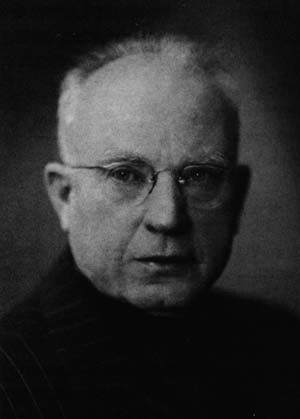
(1921-1956)
1921
Reverend E.C. Schlutz was installed as pastor on September 4. At this time the church carried a debt over $10,000.
1923-1924
Reverend Schlutz took a six month furlough to visit Europe, chiefly Germany. Reverend G. Blessin took over temporary pastoral duties. The chairmanship of the congregation was permanently transferred to laymen.
1929
The “English Mission” was now established within Salem as a full-fledged, fully-accredited sister congregation.
1932
The old St. Paul Courthouse was dismantled. Under the guidance of Reverend Schlutz, the congregation purchased some valuable cornice stone (Kasota marble) from the courthouse for a future church. Architect N. Edward Mohn was engaged to compute the amount of stone needed for the new church. The Ladies Aid (English) merged with the Ladies Aid (German). The German language was no longer used in this group. In January, the two congregations (English and German) merged to form one congregation with English as the official language. The “Nachricten,” after a span of many and useful years, was voted discontinued. In October the church celebrated 40 years of serving Christ.
1934
With her passing, Mrs. Semmler willed most of her possessions including some property to the church.
1937
Reverend Schlutz had previously acquired six tax-delinquent lots in West St. Paul. Acting on a motion by Miss Ethel Thrift, the church council was instructed to take definite action relative to a new church. The congregation purchased the lots acquired by Reverend Schlutz at their cost to him: under $300 per lot. The congregation strongly considered building the “first unit” — a basement. An agreement was also reached that a parsonage in turn be built immediately after the church basement.
1938
After a heated meeting, the congregation voted unanimously in January to instruct their architect, Mr. Mohn, to proceed with drawing up the building plans for both projects. In May the final decision was made to proceed with the project. Over 700 people attended the ground-breaking ceremony at the site of the new church on Hall and Bernard on June 12. On November 6, the last congregational meeting was held in the old church. On December 16 the basement church was dedicated. Dr. Karl Ermish preached the farewell sermon in the old church.
1939
In April, the old parsonage was sold for $3000. By July, the congregation moved to accept the plans for a new parsonage and garage. Building began at once.
1940
A February house-warming of the parsonage was accompanied by a mild blizzard. A supper followed in the church. The parsonage was dedicated in April with Reverend Elmer Braun presiding. In May, Salem’s group of women known as the “Willing Workers,” adopted the name “Cotta Society.” In July Salem hosted a service commemorating Dr. Ermisch’s 40th anniversary in the ministry.
1942
In September, Salem celebrated its 50 anniversary as a congregation with a Jubilee Service. A fellowship dinner was held at the church at which time the church mortgage was burned. The church basement was debt free.
War Years
Salem kept in close contact with her men and women in the service. Names and addresses of service people were furnished to the congregation. A service flag was dedicated with the chaplain of the 99 Minnesota Infantry as the guest speaker.
1943
By December 5 the congregation was entirely debt free. The congregation began efforts to provide funds for the main project: the superstructure and permanent sanctuary for Salem.
1944
A plan was inaugurated whereby members donated war bonds to the church’s building fund. By October Salem had $25,000.
1946
In September a celebration was held in honor of Reverend Schlutz’s 25 anniversary at Salem.
1949
In March a Men’s Club was organized. Excitement and talk centered on the superstructure and the ‘New Church.’ Estimates were that the new church would cost $100,000 to 125,000. Salem had $42,000 in the building fund.
1950
A four hour congregational meeting was held to discuss the type of building wanted by Salem. Proposed plans for the interior were well received while those for the exterior were somewhat controversial. By November, agreement was reached on exterior and interior plans and the congregation approved the plans of the architect. The architects were Magney, Turner and Setter who used a church in the mountains of Mexico as their inspiration.
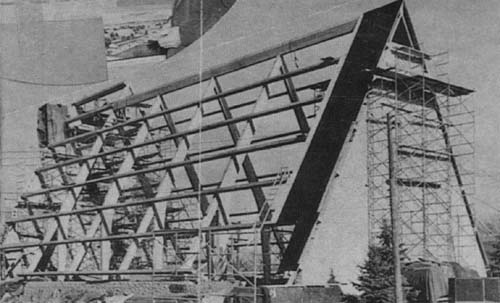
1951
In April, 5 the congregation voted to borrow any additional funds needed to construct the superstructure and the contractors were instructed to go ahead as soon as the money was available. In May the “Tithing Plan” was adopted whereby each member was to donate 10% of his income for one year. This plan proved to be a marked success as a large number of members adopted the plan, a considerable number of contributions exceeded the tithe. Construction by the Kraus-Anderson Co. continued but not without inconvenience to the congregation. In September Reverend E.H. Doerring of Highland Park Lutheran Church, St. Paul, preached at the cornerstone laying ceremony. Basic construction cost for the new church were to be $144,091.
1952
The Ladies Cotta Society bought modern white oak pews for the new church at a cost of $5,300. The choir planned to buy new robes. Lyle Ingelbert, an intern from Luther Seminary, was engaged to help Reverend Schlutz and Henry Mayer was to assist in the summer months. A dedication date was set for September but had to be postponed until spring. Donations of $1,800 had already been received for an altar. In May the long-awaited day occurred as the first service was held in the superstructure. The church floor was titled at a cost of $1,335. The congregation adopted a plan calling for the partial overlapping of the Sunday School hour and the service. The children were to attend the service until after the sermon and then proceed to their classes. The plan was a success and continued for some time. In June a $4,000 Wurlitzer organ was purchased and dedicated. In December the congregation honored Reverend and Mrs. Schlutz on their 25 wedding anniversary. Also in December the new choir robes were worn, and a new wrought iron lectern was installed.
1953
In March the new pews were installed. Carpeting in the chancel and sacristy was completed in April at the cost of $1,297. A wrought iron baptismal font and sterling silver bowl were donated by the Ladies Cotta Society. The newly completed Salem Lutheran Church was dedicated on April 26. At 10:00 a.m. altar dedication sermons were given by Reverend Elmer J. Braun and Dr. Karl Ermisch. The altar had been carved and sculptured in Italy from white carrara marble and depicts the Last Supper in relief. Three mahogany figures placed on top of the altar had been carved by a local artist, Mikels Geistaut. The figures represent two angels “adoring the triumphant Christ.” On September 20 Henry Mayer was ordained and installed at Salem as assistant pastor with sermons by Dr. Karl Ermisch and Reverend E.C. Schlutz.
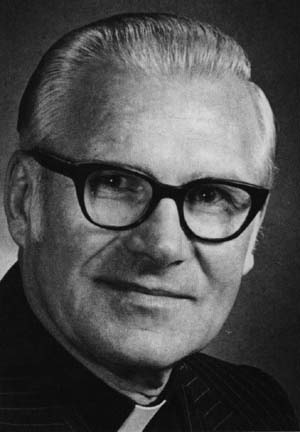
(1956-1967)
1956
On March 18 Reverend Norbert A. Augst was installed as pastor at Salem. The Kaiser property, an 80 foot frontage on Humboldt Avenue, was purchased for future classroom space.
1958
In April the Capital Fund Drive was begun to reduce the mortgage on church property. An organ fund was established, which grew to $9,100 by 1965.
1960
A planning committee was established in January to study needs and finances necessary to build a Parish Education Building. The purchase of the Schmidt and DeWoody properties in October gave another 80 feet of frontage on Humboldt Avenue.
1961
The congregation voted to go ahead with the education building, and in November the architects’ preliminary drawings were accepted. The Cerney Association, Inc. served as architects.
1962
By March the congregation had accepted the bid of the Bretoi Construction Company. The congregation voted to borrow the necessary funds. Classes were held in November for the first time in the new parish Educational Building. The building was dedicated on November 18 with Dr. E.C. Reinertson, President of Southeast Minnesota District, conducting the service of dedication. In September Pastor Alexander Eisner became Salem’s Visitation pastor.
1965
A new electric organ was purchased and installed at a cost of $14,358. The reverend Arnold Thalacker was installed in September as assistant pastor. He served until July 1966.
1967
The organ was paid off and a balcony pew fund established. In September Salem celebrated its 75 year with special services, programs and a picture display. Many members dressed in old fashioned costumes.
1968
In January Reverend Jules Quello was installed as Salem’s pastor. The church budget was $75,099. New church lights were installed and more pews were added. Salem began the year with 1,314 baptized and 946 confirmed members.
1970
The Sunday School enrollment was 403, and Salem joined the St. Paul Lutheran Council. In July Pastor Reg Torrison was installed as Salem’s assistant pastor. A Boy Scout Troop was started at Salem. The kitchen was refurbished at a cost of $15.360.
1971
The congregation approved plans for a chancel renovation on May 16. Mr. Potente was chosen as architect and the project eventually cost $47,753. The large mosaic on the wall behind the altar was secured from Italy.
1972
The April 12 minutes record that Pastor Quello chased a bat around at the council meeting. On November 12 Pastor Erling Tungseth was installed as Salem’s pastor. The boiler exploded late in the year.
1973
Communion settings started to include a folk setting. On June 3 Communion was expanded to include fifth and sixth graders.
1974
The congregation moved to open communion to all who were of age and sincerely believed in the redemption of Christ. We went to two communion settings — contemporary and traditional.
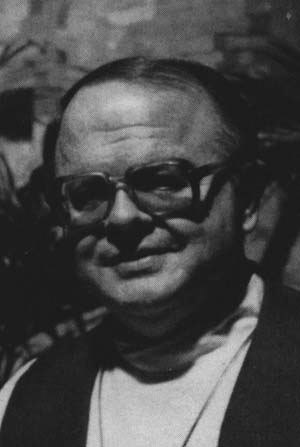
(1975-1988)
1975
On January 5 Pastor Bradly Enerson was installed as Associate Pastor. In July the congregation voted to sponsor a Vietnamese refugee family. Very soon the Bui Van Sau family arrived. After much work, the Salem Work Team” repainted, remodeled, and spruced up the rented old-Nasvik home so by September the family could move in. On October 19 Pastor John Parbst was installed as Salem’s senior pastor.
1976
The confirmed membership now stood at 1259. Salem went to two church services with Sunday school between services so families could attend church together. The weekly bulletin was begun.
1977
In January Pastor Schultz was made Pastor Emeritus. The congregation undertook a project to repair the roof and do some painting at a cost of $58,000. On October 12 Pastor Emeritus Schlutz died. Discussion began concerning a Bell Tower as a memorial to Pastor Schlutz.
1978
A Bell Tower fund was established, and on October 12 the congregation gave approval to undertake the construction of a Bell Tower. Ed Frenette was the architect and Concrete Design Specialties did the construction. The bell was obtained through Mass-Rowe Carillon Company.
1979
On September 9 the Memorial Bell Tower in honor of the Reverend E.C. Schlutz was dedicated. The cost of the project came to $63,724. The tower was adorned with a memorial plaque, and the bell was a Paccard Bronze bell cast in France.
1980
On June 1st the congregation voted to sponsor another Southeast refugee family. The Yang family (Hmong refugees) Shoua Lor and her four children: Blia, Ying, Bai, and Xiong, arrived in July. In August the congregation moved to buy and repair a house at 4 West Winona. The family was settled in October.
1981
Reverend Peter Raquet was installed as assistant pastor on January 11. Mr. Bui, Salem’s first sponsored refugee, became a U.S. citizen. The SLCW decided to refurbish the fireside room. Salem hired a Director of Youth and Parish Life, Rob Schultz.
1982
In July the 90 Anniversary Committee met. Theme for the celebration was “Shalom — Peace — Salem.” October 20, actual date of the anniversary, there was an evening service honoring the elderly. October 24 was Heritage Sunday. Reverend Reg Torrison, former pastor, was the guest speaker.
1983
Shoua Lor and her children moved from the home bought for them at 4 West Winona St. in St. Paul to Fresno, California, to be with Shaua’s sister. The council began to discuss plans to renovate Fellowship Hall and the first floor bathrooms. Director of Youth, Rob Schultz and family moved into the house at 4 West Winona St.
1984
It was a congressional decision to permit pastors to occupy the parsonage or obtain their own housing with a housing allowance. Pastor Raquet vacated the parsonage in May, and Rob Schultz moved in. The house at 4 West Winona was put up for sale.
1985
Jan Wilson was elected as the first woman president of the church council. In June Reverend Norbert Augst, a former Salem pastor, returned as a visitation pastor. In July Reverend Donald R. Reisig came to Salem from Albert Lea as associate pastor. In early summer when his daughter had finished her school year, Reverend Raquet and family moved to Switzerland.
1986
An Agreement Plan for the merger of the “American Lutheran Church”, “The Lutheran Church in America”, and “Association of Evangelical Lutheran Churches” was to become the “Evangelical Lutheran Church in America”. The new headquarters was to be in Chicago.
1988
In January Reverend John Parbst announced plans for his retirement, after serving Salem for 15 years. Reverend Donald R. Reisig was called to become the Senior Pastor in November. The congregation voted to proceed with an East addition of 3,440 square feet, 8 new Sunday School rooms, two new pastors’ offices, a new youth room, and the remodeling of Fellowship Hall. The total cost of the program was $628,616.
1989
In January the new addition was dedicated. In April the congregation voted that Reverend Lisa Holt, a youth director at Salem during her internship, be called for the position of Associate Pastor of Youth and Family Ministries at Salem. At the January meeting the Staff Needs Assessment Committee recommended a full-time youth director and a full-time director of Parish Life. Brian Peterson resigned as Youth Director and Maggie Novak was hired as Director of Parish Life. The annual Christmas Pageant became an all-congregational event and featured participants and actors from all age groups.
1990
On May 20 Salem members ratified some changes in the constitution: The church name was changed from “Salem Lutheran Church” to “Salem Evangelical Lutheran Church”. All references to the “American Lutheran Church” would read “Evangelical Lutheran Church in America”. All references to the “South-East Minnesota District” were changed to “St. Paul Synod”. The district president would be referred to as Synod Bishop.
1991
May 19 the original Salem Lutheran Church at South Robert Street and Bunker burned to the basement. It had been sold several times and was occupied at the time by St. Mary’s Antiochian Orthodox Church. A few tears were shed by elderly Salem members who recalled services in the little building. By Christmas Eve St. Mary’s had been mainly rebuilt and the congregation celebrated the Savior’s birth in the new building. In June a special meeting of the congregation voted to sell the parsonage and the property next to the church on Hall Avenue. The council was to make recommendations as to how to use the money derived from this sale. It was sold in the fall for $92,000. October 20 was the kick-off day of Salem’s Centennial Year with a march from the site of the old Salem Church to the present Salem followed by a Sauerkraut dinner. The all-congregation Christmas Pageant featured a look at Salem Christmases over the past 100 Years.
1995
In 1995, Pastor Donald Reisig accepted a call to Moorhead, MN, and left Salem. Harry Mueller served as Interim pastor.
1996
Mark Hendrickson was called and assumed the duties of Senior Pastor at Salem in the Fall of 1996.
1999
On June 22, 1999, funeral services were held at Salem for Pastor Lisa Holt Thompson (who was then serving as pastor at Westwood Lutheran Church in St. Louis Park, MN). Pastor Lisa’s passing at age 38 from a heart attack was deeply felt by all Salemites that worked with her and knew her — especially the youth members with whom she had worked so closely.
2000
The worship area of the church received an extensive renovation/remodeling with added windows, renovated church front, balcony removal, special area for handbells at the rear of the church.
2006
Pastor Mark Hendrickson left as Salem Senior Pastor in November of 2006.
2007
Marilyn Breckenridge was assigned by the Synod to be Interim Pastor. Pastor Marilyn Breckenridge assumed the Interim Pastor position in February, 2007 (last Sunday — January 18, 2009). In October of 2007, Heritage Sunday was celebrated — 115 years.
2009
Lynn Erickson was called to become Salem’s Pastor in January 2009. Lynn was ordained and installed at Salem on January 24. In September Maggie Novak, Director of Parish Life, left after celebrating 20 years of service to Salem.
